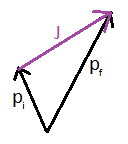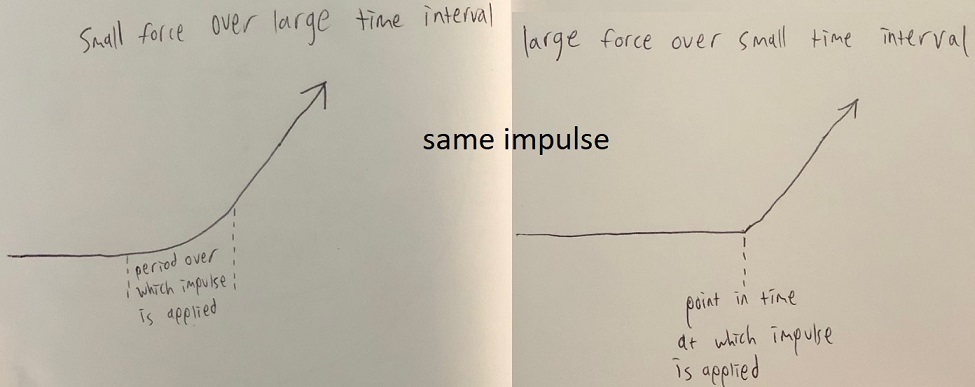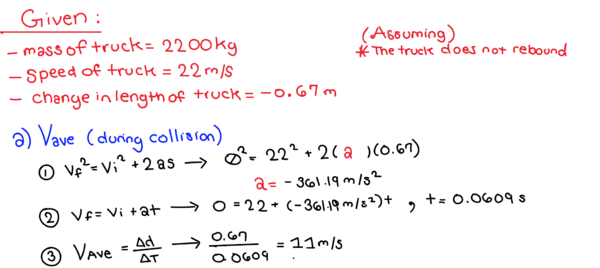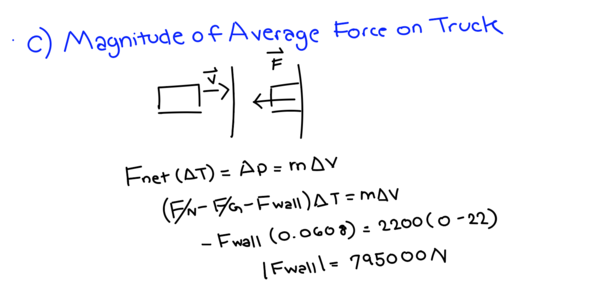Impulse and Momentum
This page defines impulse and describes its relationship to momentum.
The Main Idea
Impulse, represented by the letter [math]\displaystyle{ \vec{J} }[/math], is a vector quantity describing both the nature and duration of a force. It is defined as the time integral of the net force vector: [math]\displaystyle{ \vec{J} = \int \vec{F}_{net}dt }[/math]. Recall from calculus that this is equivalent to [math]\displaystyle{ \vec{J} = \vec{F}_{net, avg} * \Delta t }[/math], where [math]\displaystyle{ \Delta t }[/math] is the time interval over which the force is exerted and [math]\displaystyle{ \vec{F}_{net, avg} }[/math] is the time average of the net force over that time interval. For constant force, the average force is equal to that constant force, so the impulse [math]\displaystyle{ \vec{J} }[/math] exerted by constant force [math]\displaystyle{ \vec{F} }[/math] is [math]\displaystyle{ \vec{F} * \Delta t }[/math]. The most commonly used metric unit for impulse is the Newton*second.
People are interested in impulse primarily because of its relationship to momentum, as described by the impulse-momentum theorem. The theorem states that if an impulse is exerted on a system, the change in that system's momentum caused by the force is equal to the impulse: [math]\displaystyle{ \Delta \vec{p}_{system} = \vec{J} }[/math]. (It is important to note that these are vector quantities, so the impulse determines both the magnitude and direction of the change in momentum of a system.) This works out dimensionally because the units for impulse are equivalent to the units for momentum. For example, the Newton*second is equivalent to the kilogram*meter/second because a Newton is defined as a kilogram*meter/second^2. Often, the system in question consists of a single particle whose motion we want to predict. The impulse-momentum theorem is often used to calculate the final momentum of a particle using its initial momentum, the forces acting on it, and the durations of those forces.
A Mathematical Model
Derivation
The impulse-momentum theorem is a consequence of the momentum principle. Below is its derivation:
[math]\displaystyle{ \vec{F}_{net} = \frac{d\vec{p}}{dt} }[/math]
can be arranged to [math]\displaystyle{ d\vec{p} = \vec{F}_{net}dt }[/math].
Integrating both sides yields [math]\displaystyle{ \int d\vec{p} = \int \vec{F}_{net}dt }[/math]
which simplifies to [math]\displaystyle{ \Delta \vec{p} = \int \vec{F}_{net}dt = \vec{J} }[/math], which may also be written as [math]\displaystyle{ \vec{p}_f = \vec{p}_i + \vec{J} }[/math].
In the above derivation, [math]\displaystyle{ \vec{F}_{net} }[/math] is the instantaneous force acting on the system.
Constant Force
Remember that for constant force, [math]\displaystyle{ \vec{J} }[/math] and therefore [math]\displaystyle{ \Delta \vec{p} }[/math] are equal to [math]\displaystyle{ \vec{F} * \Delta t }[/math]. This form is often used for constant and nearly-constant forces because multiplying force by time is easier than performing a true integral.
Large Forces With Small Durations
Sometimes, an impulse is delivered by a very strong force over a very short duration. An example of such a situation the striking of a baseball with a baseball bat. In these situations, when modeling the motion of the particle on which the impulse is exerted, the impulse is often considered to be instantaneous (that is, it takes place at a single point in time instead of over a time interval). A common consequence of this approximation is that the position of the particle does not change while the impulse is applied. Another consequence is that the magnitude of the force is considered infinite, although the infinitely small duration of the force results in a finite impulse.
For example, consider a particle with momentum <1, 0, 0> kg*m/s. The particle is moving with constant speed in the +x direction. Then, an impulse of <0, 1, 0>N*s acts on the object. At the end of the impulse, the particle's new momentum is <1, 1, 0> kg*m/s; the particle is now moving diagonally. If the impulse was the product of a weak force over a long duration, the particle will have continued to move during its application, resulting in a curved trajectory like the one on the left. If the impulse was the product of a very strong force over a very short duration, the particle will abruptly change momentum, resulting in a sharp turn as shown on the right.
Note that in both cases, the impulse vector is the same and so the final momentum is the same, but the shape of the trajectory is different because it depends on more than just the impulse vector- it depends on the magnitude and duration of the force.
A Computational Model
In computational simulations of particles using Iterative Prediction, a momentum variable is assigned to each particle. Such simulations occur in "time steps," or iterations of a loop representing a time interval. In each time step, the particles' momenta are updated according to the impulse-momentum theorem. Usually in this kind of simulation, the time steps are so small that the force does not significantly vary over the course of any one time step. By approximating the force as constant over these short intervals, we are allowed to use the formula [math]\displaystyle{ \Delta \vec{p} = \vec{J} = \vec{F} * \Delta t }[/math]. This is called the "update momentum" technique.
The following is an example of a line of vPython responsible for updating the momentum of a particle according to the impulse-momentum theorem:
p = p + fnet*deltat
(This line would typically be written within a loop, continually adjusting momentum as the simulation progresses as part of the iterative prediction algorithm.)
The simulation below is an example of a program that uses the momentum principle. It simulates the motion of a cart, represented by a rectangle, being blown by a gust of wind:
https://trinket.io/glowscript/ce43925647
For more information, see Iterative Prediction.
Examples
1. (Simple)
A 2kg particle is travelling in the +y direction at 4m/s. After an impulse is applied to it, the particle is travelling in the +x direction at 3m/s. The impulse consisted of a force applied for .02s. What was the magnitude of the average force?
Solution:
[math]\displaystyle{ \vec{J} = \Delta\vec{p} = \vec{p}_f - \vec{p}_i = \lt 6, 0, 0\gt - \lt 0, 8, 0\gt = \lt 6, -8, 0\gt . }[/math] N*s
The impulse is the product of the average force and the time interval over which it was applied.
[math]\displaystyle{ \vec{F} = \frac{\vec{J}}{\Delta t} = \lt 6, -8, 0\gt / .02 = \lt 300, -400, 0\gt }[/math] N
[math]\displaystyle{ |\vec{F}| = \sqrt{300^2 + (-400)^2 + 0^2} = 500 }[/math] N
Note that at any given moment, the force acting on the particle may be something other than <300, -400, 0>N; this is simply the average force over the .02s interval. (However, according to the mean value theorem, there must be some point in time within the interval at which the force acting on the particle is the average force.)
2. (Simple)
A hockey puck is sliding along the ice with nearly constant momentum <16,0,5>kg*m/s when it is suddenly struck by a hockey stick with a constant force of <0,0,2000>N that lasts for only 3 milliseconds (3e-3s). What is the new (vector) momentum of the puck?
Answer: <16,0,11>kg*m/s
Explanation:
[math]\displaystyle{ ∆\vec{p} = \vec{F}_{net} * {∆t} }[/math] since force is constant
[math]\displaystyle{ \vec{p}_{final} - \vec{p}_{initial} }[/math] = [math]\displaystyle{ \vec{F}_{net} * {∆t} }[/math]
[math]\displaystyle{ \vec{p}_{final} }[/math] - <16,0,5>kg*m/s = <0,0,2000>N * (3e-3)s
[math]\displaystyle{ \vec{p}_{final} }[/math] = <16,0,11>kg*m/s
Note: Since the force has no x or y components, these components of the puck's momentum remain constant.
3. (Simple)
In outer space a rock of mass 5kg is acted on by a constant net force <29,-15,40>N during a 4s time interval. At the end of this time interval the rock has a velocity of <114,94,112>m/s. What is the rock's velocity at the beginning of the time interval?
Answer: <90.8,106,80>m/s
Explanation:
[math]\displaystyle{ ∆\vec{p} = \vec{F}_{net} * {∆t} }[/math] since force is constant
[math]\displaystyle{ \vec{p}_{final} - \vec{p}_{initial} = \vec{F}_{net} * {∆t} }[/math]
[math]\displaystyle{ \vec{p} = m * \vec{v} }[/math]
[math]\displaystyle{ m\vec{v}_{final} - m\vec{v}_{initial} = \vec{F}_{net} * {∆t} }[/math]
(5kg * <114,94,112>m/s) - (5kg * [math]\displaystyle{ \vec{v}_{initial} }[/math]) = <29,-15,40>N * 4s
[math]\displaystyle{ \vec{v}_{initial} }[/math] = (<29,-15,40>N * 4s - 5kg * <114,94,112>m/s)/5kg = <90.8,106,80>m/s
4. (Middling)
This problem combines the impulse-momentum theorem with a number of kinematic equations, some of which take advantage of the constant acceleration due to gravity.
Standing on Earth, you throw a small rock with a mass of 0.5 kg into the air. At the instant it leaves your hand, the rock's velocity is [math]\displaystyle{ {\vec{v}=\lt 0.1,4.0,0.3\gt m/s} }[/math] Ignore air resistance.
- Initial Momentum?
- Rock's momentum after 0.25 seconds?
- Calculate the average velocity of the rock from just after it leaves your hand to 0.25 seconds later.
- If a rock's initial position just as it leaves your hand is <0,1.2,0>m, find the vector position of the ball after 0.25 seconds.
Solution:
- Initial Momentum?
[math]\displaystyle{ {m=0.5, \vec{v} = \lt 0.1,4,0.3\gt } }[/math]
[math]\displaystyle{ {\vec{p} = m\vec{v} = \lt 0.05,2,0.15\gt kg*m/s} }[/math]
- Rock's momentum after 0.25 seconds?
[math]\displaystyle{ {\vec{p}_f=\vec{p}_i+\vec{F}_{net}(\Delta{t})} }[/math] (Note: this is the step involving the impulse-momentum theorem. We can simply multiply force by time instead of integrating because the force is constant.)
[math]\displaystyle{ {\vec{p}_f = \lt 0.05,2,0.15\gt + \lt 0,(-9.8)(0.5),0\gt *0.25 = \lt 0.05,2,0.15\gt + \lt 0,-1.225,0\gt } }[/math]
- [math]\displaystyle{ {= \lt 0.05,0.775,0.15\gt kgm/s} }[/math]
- Calculate the velocity of the rock from just after it leaves your hand to 0.25 seconds later.
[math]\displaystyle{ {\vec{p}=m\vec{v}, \vec{v}=\vec{p}/m} }[/math]
[math]\displaystyle{ {\vec{v}_f=(\vec{p}_f/m)=(1/0.5)*\lt 0.05,0.775,0.15\gt } }[/math]
- [math]\displaystyle{ {=\lt 0.1,1.55,0.3\gt m/s} }[/math]
[math]\displaystyle{ {\vec{v}_{avg}=(\vec{v}_i+\vec{v}_f)/2 = (0.5)*[\lt 0.1,4,0.3\gt + \lt 0.1,1.55,0.3\gt ]= (0.5)\lt 0.2,5.55,0.6\gt } }[/math]
- [math]\displaystyle{ {=\lt 0.1,2.775,0.3\gt m/s} }[/math]
- If a rock's initial position just as it leaves your hand is <0,1.2,0>m, find the vector position of the ball after 0.25 seconds.
[math]\displaystyle{ {\vec{r}_i=\lt 0,1.2,0\gt m} }[/math]
[math]\displaystyle{ {\vec{r}_f=\vec{r}_i+\vec{v}_{avg}(\Delta{t})= \lt 0,1.2,0\gt + \lt 0.1,2.775,0.3\gt *0.25} }[/math]
- [math]\displaystyle{ {= \lt 0,1.2,0\gt + \lt 0.025,0.694,0.075\gt } }[/math]
- [math]\displaystyle{ {=\lt 0.025,1.894,0.075\gt m} }[/math]
5. (Middling)
In a crash test, a truck with mass 2200 kg traveling at 22 m/s smashes head-on into a concrete wall without rebounding. The front end crumples so much that the truck is 0.67 m shorter than before. Make the somewhat unrealistic assumption that the force, and therefore the acceleration, is constant. This assumption is necessary to answer some of the questions below because several of the kinematic equations rely on constant acceleration.
(a) What is the average speed of the truck during the collision (that is, during the interval between first contact with the wall and coming to a stop)?
(b) About how long does the collision last? (That is, how long is the interval between first contact with the wall and coming to a stop?)
(c) What is the magnitude of the average force exerted by the wall on the truck during the collision?
(a)
Here, we use kinematic equations to solve for average velocity!
(b)
(c)
6. (Difficult)
At t=0, an 8kg particle is released from rest near the surface of the earth. In addition to the gravitational force, a time dependent force [math]\displaystyle{ \vec{F(t)} }[/math] acts on the particle, where [math]\displaystyle{ \vec{F(t)} = \lt 200 t \sin (t^2), 0, 0\gt }[/math] Newtons. Use g = 10 for this problem.
What is the velocity of the particle at t=2?
Solution:
The net force acting on the particle can be found by adding the gravitational force and [math]\displaystyle{ \vec{F} }[/math]:
[math]\displaystyle{ \vec{F}_{net} = \lt 200 t \sin (t^2), -80, 0\gt }[/math] N.
Let us find the impulse exerted on the particle:
[math]\displaystyle{ \vec{J} = \int_0^2 \vec{F}_{net} dt }[/math] N*s
[math]\displaystyle{ = \int_0^2 \lt t \sin (t^2), -80, 0\gt dt }[/math] N*s
[math]\displaystyle{ = [\lt -100 \cos (t^2), -80t, 0\gt ]_0^2 }[/math] N*s (Note: u-substitution was used to integrate [math]\displaystyle{ t \sin (t^2) }[/math], setting u equal to [math]\displaystyle{ t^2 }[/math].)
= [math]\displaystyle{ \lt -100 \cos 4 + 100, -160, 0\gt }[/math] N*s
[math]\displaystyle{ \vec{p}_f = \vec{p}_f + \vec{J} }[/math] so [math]\displaystyle{ \vec{p}_f = \lt -100 \cos 4 + 100, -160, 0\gt }[/math] kg*m/s
[math]\displaystyle{ \vec{v}_f = \frac{\vec{p}_f}{m} = \lt - \frac{100}{8} \cos 4 + \frac{100}{8}, -20, 0\gt = \lt 4.32, -20, 0\gt }[/math] m/s
Connectedness
Scenario: follow through
Often in baseball and similar sports, batters are encouraged to "follow through" when hitting the ball. This does not increase the force with which the batter hits the ball, which depends on the strength of the batter, but it does increase the time of contact between the bat and the ball. This increases the duration of the force of the hit, which increases the impulse exerted on the ball, and therefore, its final speed at the end of contact.
Application: airbag industry
When a car comes to a sudden stop, such as in a collision, the driver's body will continue to move forward with its original momentum until it collides with something, such as the dashboard or an airbag, that brings them to rest. Because of the impulse-momentum theorem, for a driver with a given initial momentum, a specific impulse is required to bring the driver to rest. The purpose of airbags is to deliver this impulse over a longer time interval than a dashboard would by deforming. This longer time interval allows the force acting on the driver to be lower while achieving the same impulse, which minimizes risk of injury.
Similarly, it is better for one's joints if the knees are bent when landing from a jump because the contraction of the legs allows the impulse of landing to last longer and therefore have a smaller force.
See also
- Linear Momentum
- Newton's Second Law: the Momentum Principle
- Conservation of Momentum
- Iterative Prediction
Further reading
External links
- http://www.physicsclassroom.com/class/momentum/Lesson-1/Momentum-and-Impulse-Connection
- https://www.asc.ohio-state.edu/humanic.1/p111_lecture13
- https://study.com/academy/lesson/momentum-and-impulse-definition-theorem-and-examples.html
- https://www.physicsclassroom.com/class/momentum/Lesson-1/Real-World-Applications
- https://www.youtube.com/watch?v=qu_P4lbmV_I
References
- Sherwood, Bruce A. "2.1 The Momentum Principle." Matter & Interactions. By Ruth W. Chabay. 4th ed. Vol. 1. N.p.: John Wiley & Sons, 2015. 45-50. Print. Modern Mechanics. 8 April, 2018.
- Michael Fowler, U. Va. Physics. "Momentum, Work and Energy." Galileo and Einstein: Lecture Index. <http://galileoandeinstein.physics.virginia.edu/lectures/lecturelist.html>14 April, 2018.




